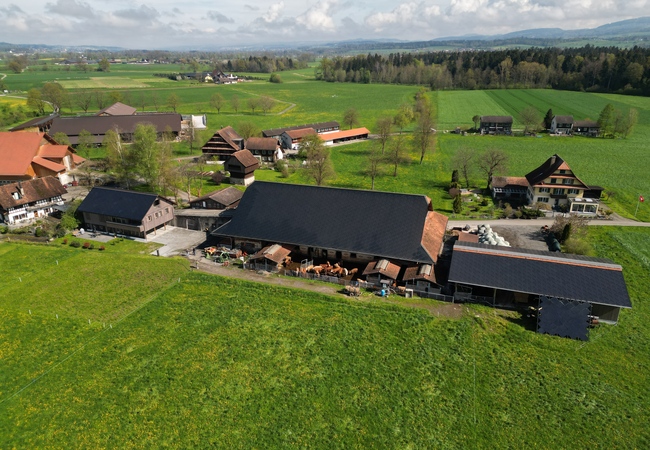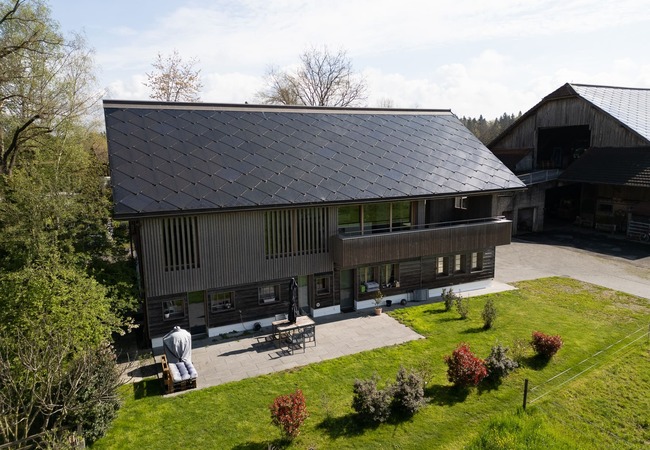Over ten years ago, Hanspeter Knüsel wanted to equip the roof of his large barn with solar panels. However, the preservation authorities threw obstacles in his way. What they didn’t anticipate was Hanspeter Knüsel’s perseverance and tireless dedication. He found a solution that met both his needs and the requirements of historical preservation. This marked the beginning of a long-term success story.

Dear Mr. Knüsel, you have covered all the roofs of your farm with SunStyle. Do you know exactly how many solar tiles are installed?
On the first large roof that we equipped in 2013, there are 880 solar tiles. Together with the other two roofs, we have a total of about 1,250 solar tiles. Although there are significantly larger systems today, that was quite large back then. Perhaps of interest: the entire system has a capacity of 154 kWp.
1,250 solar tiles in operation, wow. You can truly be considered a SunStyle fan. What was the original reason for this investment?
The idea of a solar installation first came up in 2011, mainly because of the suitable roof size and orientation. I’ve always been someone who explores new paths. So I signed up for the KEV (feed-in remuneration at cost). However, my farm was located in an area protected for its historical townscape, which posed an additional challenge. My first application was rejected because of this protection zone. So I sought a solution on my own and came across SunStyle.
I was quite surprised that such a building-integrated solution existed. My tiled roof dated back to 1940 and definitely needed replacing. That was my chance to replace the old clay tiles with solar tiles. SunStyle was therefore the optimal solution.
Besides the aesthetic benefits, there was another important reason: the barn had a structural challenge. We use a large grab in the barn, and when I grab and move half-ton hay bales with it, movements occur in the roof structure. The flexibility of the SunStyle system can easily absorb these movements.
Since I’m also involved in energy consulting, I can use my systems professionally. I have detailed monitoring of the individual roofs and can rely on years of practical evaluation. I can directly pass on this expertise to my clients.
Are there other reasons in favor of SunStyle?
As a practitioner, I was absolutely convinced by the reasons mentioned. But there are additional advantages: for example, the solar tiles are mounted overlapping, making the roof 100% waterproof. The finishing elements allow the entire roof surface to be utilized, and nowadays, these elements also produce electricity. If the metalworker does a good job with the finish, it results in a beautiful roof, which is personally very important to me. This aesthetic argument ultimately earned me approval from the preservation authorities.
How exactly did the situation with the preservation authorities unfold?
I had to convince the preservation authorities that the building would meet all the regulations with these solar tiles. That took quite a while, so I eventually had to make concessions regarding the feed-in tariff. Although I was actually one of the first, I ended up on a waiting list.
The initial effort was still worth it. When I wanted to cover the second building with the same solar tiles, I immediately got the green light. By integrating into the roof, such solutions are much easier to approve. Today, it would be even simpler because solar modules are available in different colors. Every solar roof ultimately contributes to the energy transition.
Let’s move on to another topic: What is your self-consumption rate?
One of the roofs (50 kWp) easily covers my self-consumption.
In the best years, my system has produced 170,000 kWh. For my entire operation, I need about 40,000 kWh. We are talking about my consumption as a farmer, not as a private person.
Of course, production doesn’t always occur when I need the electricity. At the moment, I have a 22 kW storage system, but I want to expand it further. In general: in the future, we will be able to significantly increase self-consumption with smart meters and other technologies.

Has the decision paid off, and when will the system pay for itself?

Yes, of course! Photovoltaics have always been a long-term but good investment. My systems have now been online for 11 years and can produce electricity for up to 25 or 30 years. So they will generate much more energy and become more profitable depending on the electricity price. Apart from that, the project is also morally valuable to me because it supports renewable energy.
With such a good roof orientation as mine, I had to take advantage of this benefit as quickly as possible. It’s like my farm, which I took over from my father. I also focused on the areas where I had the greatest advantages over my competitors. This way, I was able to continue running the farm successfully.
What do your neighbors say about your solar system?
I receive almost exclusively positive feedback. We have a bike path through the village, and cyclists regularly ask me if that is really a solar system. Most people like the roof very much, and they are amazed that it also produces electricity. Everyone is actually excited and thinks that this is the roof of the future.
Your oldest system is 13 years old, so you have years of experience. What would you do differently if you could start the project all over again?

I would definitely do it the same way again. Back then, SunStyle was still a niche product. Today, building-integrated solar systems are much more widespread, and I probably wouldn’t have to do as much research on my own.
I hope that these great solutions will become more widely known in offices and municipalities. They could then insist on these high-quality products, which combine historical preservation and solar technologies. Of course, it would be an investment, but the result would certainly look better than today’s often haphazardly installed solar systems. A village with only building-integrated solar systems would be a visionary and exceptional goal.
Finally, what is your next project?
At one of my buildings, I plan to install a facade system. For that, I still need a building permit, not just a simple notification like for the solar systems on the roof. It remains to be seen whether facades make sense in terms of performance. I’m mainly doing it to evaluate the performance of facade systems myself. This way, I can compare the efficiency of roofs with that of facades.
The perfect solution for your protected building
Is your building in a protection zone or historically important and listed? Then contact us and discover how modern solar technology can harmoniously combine with the charm of historical architecture. Our building-integrated solar systems offer an aesthetically pleasing and sustainable solution that meets both the strict requirements of historical preservation and your individual energy needs.
Our experienced experts will support you at every step of your project – from planning to installation – and help you overcome bureaucratic hurdles. Benefit from innovative technologies that transform your listed building into a model for sustainable energy generation. Be inspired by the possibilities and shape the future of renewable energy with us.

Contact us today to learn more about our tailored solutions for listed buildings. We look forward to working with you and bringing your vision to life.
Hanspeter Knüsel is not only a farmer but also a visionary pioneer in the use of renewable energy. In an inspiring interview, he shares his journey from the first solar panels on his heritage-protected property to a successful and sustainable energy concept.
For more information about SunStyle’s solar roof, visit sunstyle.com
Power your interest in the future of solar roofing by following us:
Instagram @sunstyle _solar
Facebook @sunstylesolar
LinkedIn linkedin.com/company/sunstylesolar
Youtube @youtube channel


